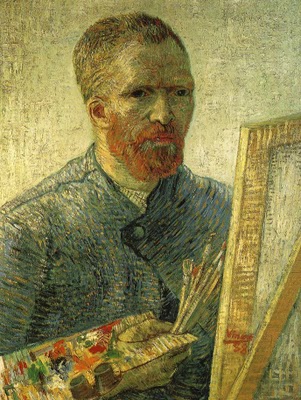21st August 2010 , Saturday; 5.45 pm
CONTEMPLATE & KONANGAL
present Documentaries on Art
Vincent Van Goah

21st August 2010 , Saturday; 5.45 pm
Contemplate Art Gallery
Rajshree Ford Buildings, Avanashi Road
(Opp. Krishnammal College)
http://www.contemplate.co.in
http://konangalfilmsociety.blogspot.com
Contemplate:
is an initiative that will incubate art events, collaborations
with artists and art organizations to mount unique platforms,
support workshops to encourage new dialogues and creating forums
and opportunities for cultural exposure. Konangal film society has been active from 2003 in Coimbatore.
Apart from screening world cinema, screening of documentaries on
art once every month was part of regular screening schedule of
Konangal.
This is the first of the series of art documentaries that will be
screened once every month jointly by Contemplate and Konangal.
These documentaries will cover a broad range of disciplines of Art
, from classic , to contemporary
.
 Vincent Van Gogh, ( March 30, 1853), generally considered the
greatest Dutch painter and draughtsman after Rembrandt. With
Cézanne and Gauguin the greatest of Post-Impressionist artists. He
powerfully influenced the current of Expressionism in modern art.
His work, all of it produced during a period of only 10 years,
hauntingly conveys through its striking colour, coarse brushwork,
and contoured forms the anguish of a mental illness that
eventually resulted in suicide.
Vincent Van Gogh, ( March 30, 1853), generally considered the
greatest Dutch painter and draughtsman after Rembrandt. With
Cézanne and Gauguin the greatest of Post-Impressionist artists. He
powerfully influenced the current of Expressionism in modern art.
His work, all of it produced during a period of only 10 years,
hauntingly conveys through its striking colour, coarse brushwork,
and contoured forms the anguish of a mental illness that
eventually resulted in suicide.
In 1869 van Gogh went to work in The Hague. In 1873 he was sent to
the London and fell unsuccessfully in love with the daughter of
the landlady. This was the first of several disastrous attempts to
find happiness with a woman. His father was a Protestant pastor,
and van Gogh first trained for the ministry, but he abandoned his
studies in 1878 and went to work as a lay preacher among the
impoverished miners of the grim Borinage district in Belgium.
From this time he worked at his new `mission' with single-minded
frenzy, and although he often suffered from extreme poverty and
undernourishment, his output in the ten remaining years of his
life was prodigious: about 800 paintings and a similar number of
drawings.
From 1881 to 1885 van Gogh lived in the Netherlands, sometimes in
lodgings, supported by his devoted brother Theo, who regularly
sent him money from his own small salary. In keeping with his
humanitarian outlook he painted peasants and workers, the most
famous picture from this period being The Potato Eaters Of this he
wrote to Theo: `I have tried to emphasize that those people,
eating their potatoes in the lamp-light have dug the earth with
those very hands they put in the dish, and so it speaks of manual
labour, and how they have honestly earned their food'.
In 1885 van Gogh moved to Antwerp, and in February 1886 he moved
to Paris, where he met Pissarro, Degas, Gauguin, Seurat, and
Toulouse-Lautrec. At this time his painting underwent a violent
metamorphosis under the combined influence of Impressionism and
Japanese woodcuts, losing its moralistic flavour of social
realism. Van Gogh became obsessed by the symbolic and expressive
values of colors and began to use them for this purpose rather
than, as did the Impressionists, for the reproduction of visual
appearances, atmosphere, and light. `Instead of trying to
reproduce exactly what I have before my eyes,' he wrote, `I use
color more arbitrarily so as to express myself more forcibly'.
In February 1888 van Gogh settled at Arles, where he painted more
than 200 canvases in 15 months. During this time he sold no
pictures, was in poverty, and suffered recurrent nervous crisis
with hallucinations and depression. He became enthusiastic for the
idea of founding an artists' co-operative at Arles and towards the
end of the year he was joined by Gauguin. But as a result of a
quarrel between them van Gogh suffered the crisis in which
occurred the famous incident when he cut off his left ear (or part
of it), an event commemorated in his Self-Portrait with Bandaged
Ear .
In May 1889 he went at his own request into an asylum at St Rémy,
near Arles, but continued during the year he spent there a
frenzied production of tumultuous pictures such as Starry Night
(MOMA, New York). He did 150 paintings besides drawings in the
course of this year.
In 1889 Theo married and in May 1890 van Gogh moved to
Auvers-sur-Oise to be near him, lodging with the patron and
connoisseur Dr Paul Gachet. There followed another tremendous
burst of strenuous activity and during the last 70 days of his
life he painted 70 canvases. But his spiritual anguish and
depression became more acute and on 29 July 1890 he died from the
results of a self-inflicted bullet wound.
He sold only one painting during his lifetime (Red Vineyard at
Arles; Pushkin Museum, Moscow), and was little known to the art
world at the time of his death, but his fame grew rapidly
thereafter. His influence on Expressionism, Fauvism and early
abstraction was enormous, and it can be seen in many other aspects
of 20th-century art. His stormy and dramatic life and his
unswerving devotion to his ideals have made him one of the great
cultural heroes of modern times, providing the most auspicious
material for the 20th-century vogue in romanticized psychological
biography.(Source:Internet)
Posted by Konangal - Phone: 9443039630
konangal@gmail.com

